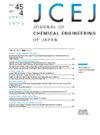基于多极限学习机的计算流体力学模拟数据快速预测锅炉热流密度分布
IF 1.2
4区 工程技术
Q4 ENGINEERING, CHEMICAL
引用次数: 0
摘要
燃煤锅炉水冷壁的传热和水动力安全是火电机组安全稳定运行的重要保证。近年来,受煤质变化和负荷波动的影响,水壁结灰结渣和热负荷波动给炉膛传热安全带来了很大的挑战。监测炉内水冷壁热流密度分布,确保受热面安全是当务之急。提出了一种基于计算流体力学(CFD)和极限学习机(ELM)的350mw锅炉热流密度分布计算方法。首先,利用ANSYS Fluent软件对锅炉120种典型工况进行模拟,表征热流密度分布。其次,针对CFD模拟计算成本高的问题,将模拟数据与锅炉实际运行参数相结合,建立了基于多elm的热流密度分布预测模型。利用SOFA风门开度和主燃烧器二次风门开度两个参数,将120种工况划分为6类,并利用K-means算法求出每一类工况的中心工况。在每个类别中,随机选取特定工况的热流密度数据作为验证集,验证热流密度分布预测模型的有效性。最后,将基于多重elm的热流密度分布预测模型与基于四种现代神经网络算法的预测模型进行了比较。结果表明,对于多elm模型,预测误差<10%,表明该模型能够准确预测锅炉热流密度分布,为实际生产过程的调节提供指导。本文章由计算机程序翻译,如有差异,请以英文原文为准。
Fast Prediction of Heat Flux Distribution in Boilers Using Computational Fluid Dynamics Simulation Data via Multi-Extreme Learning Machines
The heat transfer and hydrodynamic safety of the water-cooled wall in coal-fired boilers are important guarantees for the safe and stable operation of thermal power units. In recent years, influenced by coal quality changes and load fluctuation, the ash deposition and slagging of the water wall and the fluctuation of heat load bring great challenges to the furnace heat transfer safety. It is urgent to monitor the heat flux distribution of the water-cooled wall in the furnace to ensure the safety of the heating surface. In this study, a calculation method for heat flux distribution of 350 MW boiler based on computational fluid dynamics (CFD) and extreme learning machine (ELM) is proposed. First, 120 typical operating conditions in boiler were simulated using ANSYS Fluent to characterize heat flux distribution. Next, to circumvent the high computational cost of CFD simulations, a heat flux distribution prediction model based on multi-ELM was developed by integrating the simulation data and the actual operating parameters of the boiler. Two parameters, namely, separated over-fire air (SOFA) damper opening and main burner secondary air damper opening, were applied to divide the 120 operating conditions into six categories, and use K-means algorithm to find the central operating condition of each category. In each category, the heat flux data of a specific operating condition were randomly selected as the verification set, and the validity of the heat flux distribution prediction models was verified. Finally, the prediction models of heat flux distribution based on multi-ELM were compared with the prediction models based on four contemporary neural network algorithms. Results showed that for the multi-ELM model, the prediction error was <10%, showing that it can accurately predict the heat flux distribution of a boiler and provide guidance for the regulation of the actual production process.
求助全文
通过发布文献求助,成功后即可免费获取论文全文。
去求助
来源期刊

Journal of Chemical Engineering of Japan
工程技术-工程:化工
CiteScore
1.70
自引率
12.50%
发文量
51
审稿时长
1.9 months
期刊介绍:
The Journal of Chemical Engineering of Japan (JCEJ) is a monthly publication in English of the Society of Chemical Engineers, Japan. The first issue appeared in 1968. JCEJ publishes timely original research in the broad field of chemical engineering ranging from fundamental principles to practical applications. JCEJ is an international research journal and invites your contributions and subscriptions.
All areas of chemical engineering are covered, including:
Physical Properties and Physical Chemistry,
Transport Phenomena and Fluid Engineering,
Particle Engineering,
Separation Engineering,
Thermal Engineering,
Chemical Reaction Engineering,
Process Systems Engineering and Safety,
Biochemical,
Food and Medical Engineering,
Micro and Nano Systems,
Materials Engineering and Interfacial Phenomena,
Energy, Environment, and
Engineering Education.
 求助内容:
求助内容: 应助结果提醒方式:
应助结果提醒方式:


